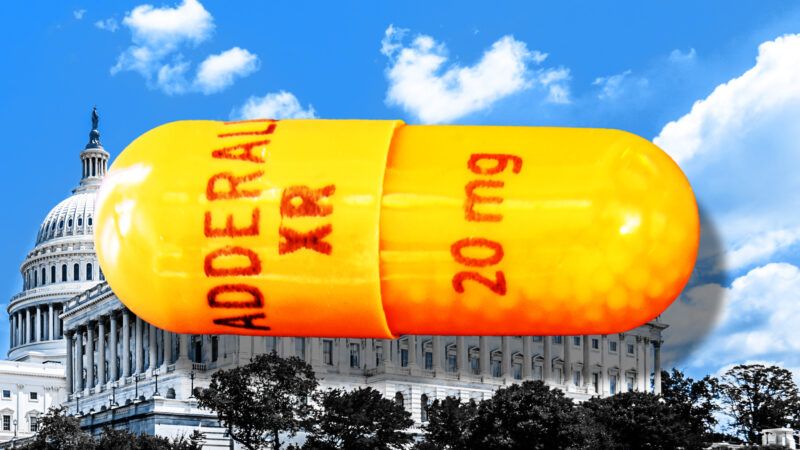Blame the Government for the Adderall Shortage
Limiting the supply of a controlled substance does not remove demand. Users simply look elsewhere, including more unsavory sources.

The fallout from the COVID-19 pandemic continues: This week, the Food and Drug Administration (FDA) announced that there is a shortage of Adderall. The pharmaceutical stimulant is prescribed to treat attention-deficit/hyperactivity disorder (ADHD), a neurological disorder that inhibits focus in children and adults alike.
In its announcement, the FDA contended that Teva Pharmaceuticals, the largest manufacturer of Adderall and its generic equivalents, is "experiencing ongoing intermittent manufacturing delays," and while other companies also make the drug, "there is not sufficient supply to continue to meet U.S. market demand through those producers." Shortages may persist until March.
The FDA's announcement misses one important detail: the government's own role in the shortage.
During the pandemic, ADHD diagnoses skyrocketed. The Drug Enforcement Administration (DEA) had opened up the field of telemedicine by allowing physicians to issue prescriptions without an in-person visit. Then the sudden shift to Zoom schooling and parents doing double duty as their child's primary instructor revealed symptoms of hyperactivity and inattentiveness that may otherwise have gone unnoticed.
Adderall is classified as a Schedule II drug, meaning it has medicinal value but "a high potential for abuse." The DEA is empowered by federal law to "determine the total quantity of each basic class of controlled substance…necessary to be manufactured during the following calendar year." It then sets an Aggregate Production Quota (APQ) to "determine the annual quantities of controlled substances…available for national medical, scientific, and industrial use."
The Wall Street Journal reported today that even though the FDA only announced the shortage this week, "manufacturers and retailers have been signaling for months" that it was becoming harder and harder to fill Adderall prescriptions. Bloomberg reported in early August that "packaging capacity constraints" at a Teva factory were causing Adderall supply disruptions. Last month, NPR reported that a "labor shortage" was the culprit.
Despite the shortage, the DEA has indicated that it does not intend to raise the limit next year.
The persistent supply chain issues may genuinely have been the cause of the shortage. But it's worth contemplating whether there would have been an issue at all if the DEA didn't intentionally constrain the supply of Adderall that can even be produced. Teva and the other drug manufacturers know their own potential output best, and they're also better equipped to plan for any externalities like labor or packaging disruptions.
In fact, a Teva spokesperson mentioned DEA quotas as a contributing factor in the continuing shortage. In 2011, Shire similarly charged that the DEA caused shortages by not approving supply increases in a timely manner.
If untreated, ADHD can cause a child to fall behind in school, and adults' job performance may suffer.
Adderall is indeed ripe for abuse: In its 2021 APQ proposal, the DEA said that "approximately 5-10 percent of high school students and 5-35 percent of college students" use the drug without a prescription. But as with any controlled substance, limiting the supply does not remove demand; users simply look elsewhere, including more unsavory sources. Earlier this year, Ohio State University warned that two students died after ingesting counterfeit Adderall that contained fentanyl.


Show Comments (60)